User experience e-books
It won’t have escaped your notice that despite many
companies investing in user experience, everyday consumer products still
have the ability to frustrate the living daylights out of people. I
argue this is because marketing teams, influenced by big retailers,
unwittingly block the design team’s view of the end user.
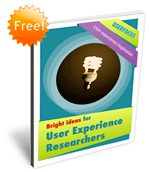
Bright Ideas for User Experience Researchers
If you're a user experience researcher, start here. This eBook contains 91 pages of real-world help on topics like field visits, usability expert reviews and personas.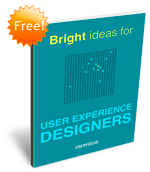
Bright Ideas for User Experience Designers
If you're a user experience designer, start here. This eBook contains 100 pages of real-world help on everything from prototyping to writing user support.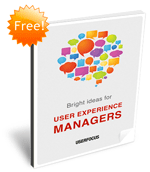
Bright Ideas for User Experience Managers
If you're a user experience manager (or just like to take a strategic view), start here. This eBook contains 78 pages of real-world help on subjects like recruiting UX staff, selling usability and institutionalising usability in your organisation.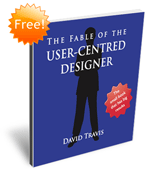
The Fable of the User-Centered Designer
Follow a young man's journey as he discovers the three secrets of user-centred design. It's a small book that has big results — and it's free.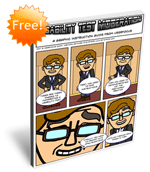
Usability Test Moderation: The Comic
If you've been tasked with running a usability test, then you'll love this instructional guide. Aimed at people about to moderate their first usability test, this graphic instruction guide covers the essential techniques you'll need to moderate a usability test. Free to newsletter subscribers.
Bluffers' guide to ISO 9241
ISO 9241 is widely cited by user experience experts who would be hard pushed to name any other standard — but all most usability professionals know about the standard is its name. This eBook describes each of the published parts of ISO 9241 in detail. £9.
Usability Test Plan Toolkit
This eBook contains all you need to make sure that you're fully prepared for your next usability test. The document includes easy to customise usability test forms, such as screeners, a discussion guide, questionnaires and data logging sheets. £9.
Morae for Usability Practitioners
Targeted at both new and experienced users of Morae, Morae for Usability Practitioners is a step-by-step guide to using Morae to plan, execute and analyse usability tests. Packed with insider tips and expert advice, this guide will help you use Morae to its full potential. £9.User Experience Research articles & resources

Bright Ideas for User Experience Researchers
If you're a user experience researcher, start here. This eBook contains 91 pages of real-world help on topics like field visits, usability expert reviews and personas.2 kinds of usability test
1 Oct 2012 - There are two different types of usability test and each has different aims. Which test you choose will have implications for the number of participants you test, the methodology you use and the way you log, analyse and present the data.Dealing with difficult usability test participants
3 Sept 2012 - A common concern of people running usability tests is that sooner or later they’ll run into a difficult participant. Who are these difficult characters and how can we prevent them from being a problem?You have 19 days to define your research problem
6 August 2012 - Without a clear understanding of a research problem one cannot expect customer or user research to deliver useful findings. Here are five things you can do to help better define a research problem and sharpen your research question.The Beginners’ Guide to Benchmarking User Experience
2 July 2012 - Here are 6 steps for benchmarking your user experience designs against your client’s business objectives. The same approach works whether your clients are internal to your organisation or external. The approach works for web sites, mobile apps, desktop software, intranets, consumer products, even services.The Wizard of Oz guide to usability testing mobile prototypes
1 May 2012 - It's easy to create a mobile prototype on a desktop computer. What's not quite so easy is to usability test the prototype and still allow the participant to use mobile interaction gestures like long presses and two finger pinches. We can overcome this obstacle by combining Axure's mutually exclusive non-conditional cases with Wizard of Oz usability testing.Lean ways to test your new business idea
5 March 2012 - In ‘The Lean Startup’, Eric Ries describes a design process to help manage risk when developing new products and services under conditions of extreme uncertainty. This article describes three established user experience techniques we can use to support this design process: narrative storyboarding; paper prototyping; and the Wizard of Oz.What user researchers can learn from Sherlock Holmes
4 October 2011 - The parallels between good research and good detective work are striking. In this article we take a close look at what user experience researchers can learn from the investigative methods used by detectives. And, in the spirit of all the best detective stories, we draw an important conclusion: if you want to become a better researcher you should learn to think like a detective.Do you make these 4 mistakes when carrying out a usability review?
1 September 2011 - When properly carried out, usability reviews are a very efficient way of finding the usability bloopers in an interface. But there are four common mistakes made by novice reviewers: failing to take the user’s perspective; using only a single reviewer, rather than collating the results from a team; using a generic set of usability principles rather than technology-specific guidelines; and lacking the experience to judge which problems are important.4 forgotten principles of usability testing
7 March 2011 - Many usability tests are worthless. Researchers recruit the wrong kind of participants, test the wrong kind of tasks, put too much weight on people's opinions, and expect participants to generate design solutions.The 5 habits of highly effective field researchers
6 September 2010 - You may not get many chances to visit and observe your customers at their place of work, so you want to make the most of the opportunity. But what’s the best way to run a site visit? Highly effective field researchers show 5 specific behaviours. They create a focus question, audio record the sessions, take photographs of the environment, take notes and write up a short summary of the observation immediately.The 4 questions to ask in a cognitive walkthrough
3 August 2010 - Although the cognitive walkthrough gets less coverage than Nielsen’s heuristic evaluation, it’s just as effective at uncovering interaction problems. It’s also an ideal way to identify problems that users will have when they first use an interface, without training.Creating usability test tasks that really motivate users
5 July 2010 - The magic of usability tests is that you get to see what people actually do with a system (rather than what they say they do). This gives you great insights into how people behave and how to improve your design. But if your tasks lack realism you’ll find that people just go through the motions and don’t engage with the test — reducing the credibility of your results. Here are 6 ways to captivate participants with great test tasks.Web survey design step-by-step
1 June 2010 - Many people think that the key to great web surveys is to craft good questions. Creating good questions is important but this is really just a small part of the battle. To design great web surveys you need to follow 6 steps. Following these steps will help you get the valid and accurate data you need to drive commercial business decisions.Creative ways to solve usability problems
6 May 2010 - It's sometimes said that usability professionals are good at finding problems, but not quite as good at coming up with creative solutions. This article describes a creativity technique called SCAMPER that will help you effortlessly generate dozens of design solutions to any usability problem you identify.Log usability tests like a pro
1 Apr 2010 - Observing a usability test seems simple but it's easy to lose focus during a session and record only the dramatic or obvious usability problems. As you watch the test, you should make minute-by-minute observations of the participant's behaviour as single letter codes. Datalogging ensures you note all behaviours, not just the ones that stand out, and provides all you need to quickly create a list of usability issues you can pass to the design team. This article includes a macro-free Excel spreadsheet you can use to timestamp your observations.Usability testing with hard-to-find participants
2 Nov 2009 - For most products, it's easy to track down participants for a usability test. But there are some products where end-users are difficult to find and recruit. For these products, it's better to use surrogate users as a proxy for genuine users than not to usability test at all, but you must manage the risks appropriately.How to prioritise usability problems
5 Oct 2009 - A typical usability test may return over 100 usability issues. How can you prioritise the issues so that the development team know which ones are the most serious? By asking just 3 questions of any usability problem, we are able to classify its severity as low, medium, serious or critical.How to create personas your design team will believe in
3 Aug 2009 - Does your organisation use personas to describe users' characteristics, goals, needs and behaviours? Although they are a popular tool for communicating knowledge about users, many personas are little more than anecdote, hearsay and rumour. These kind of fake personas rapidly fall into disuse. Make sure your own personas get used by validating them against this 7-item checklist.Usability Test Moderation: The Comic
1 June 2009 - If you've been tasked with running a usability test, then you'll love this instructional guide. Aimed at people about to moderate their first usability test, this free graphic instruction guide covers the essential techniques you'll need to moderate a usability test.What every usability test moderator ought to know about good listening
6 May 2009 - Moderation seems effortless but there's a lot more to good listening than opening your ears. Here are 15 suggestions to improve your own listening skills.New standards in usability
13 Jan 2009 - 2008 saw the release of several international usability standards, many within the influential ISO 9241 series. Two of these standards focus on accessibility and another provides guidelines for usable web sites. This article explains why usability standards are important and summarises the 13 new parts of ISO 9241.Writing the perfect participant screener
6 Nov 2008 - "Know thy user" is the first principle of usability, so it's important that you involve the right kind of people in your usability study. These 8 tips for screening participants will show you how to recruit articulate, representative users for your research, quickly filter out the people you don't want and help you avoid the dreaded "no show".How to run an unmoderated usability test
4 Sep 2008 - In an unmoderated usability test, a computer automates the process of administering a usability test. This means you can test with much larger samples than with a conventional test, calculate reliable measures of usability and feel confident that you're capturing your customer's context of use.Morae for Usability Practitioners
2 Aug 2008 - Targeted at both new and experienced users of Morae, Morae for Usability Practitioners is a step-by-step guide to using Morae to plan, execute and analyse usability tests. Packed with insider tips and expert advice, this guide will help you use Morae to its full potential.Site visit interviews: from good to great
2 Aug 2008 - Site visits are the best method we have of gaining real insight into the way customers work — to understand what customers do, rather than what they say they do. But to get the most from a site visit you need to polish your interviewing skills. Great interviewers show five characteristics from which we can learn.Measuring the usability of everyday products
2 Jun 2008 - ISO have released a new standard for measuring the usability of every day products, like ticket machines, mobile phones and digital cameras. This standard, ISO 20282, includes test methods for quantifying the usability of consumer products to ensure they meet a pre-defined quality level. This development is exciting because the standard's focus on usability measurement reflects a sea change in the evolving practice of usability. In the old world, usability specialists just found usability problems with a design. In the new world, usability specialists also answer the question: "How usable is this design?"Data collection for usability research
5 May 2008 - How should you go about collecting data in usability tests? This article examines the data collection process in usability studies and describes some popular data logging solutions. Since most of these tools are expensive, we show you how you can use Microsoft Excel with Visual Basic macros to collect the data.SPSS: Statistics for the mathematically challenged
2 Apr 2008 - Many people enjoy behavioural research, whether it's running a usability test, fielding a survey or observing people doing their jobs. Finding things out and making new discoveries excites our natural human curiosity. But when faced with the task of analysing the data behind the research, many people feel their excitement drain away. Most of us are not excellent mathematicians and the notion of using data to test scientific hypotheses can be intimidating. But data analysis is an important aspect of virtually all research. So how can you overcome a fear of maths to learn how to use statistics?Usability test datalogger
2 Apr 2008 - This Excel spreadsheet allows you to measure task completion rates, time-on-task, analyse questionnaire data, and summarise participant comments. Latest version just released!Measuring satisfaction: Beyond the usability questionnaire
3 Mar 2008 - Most usability tests culminate with a short questionnaire that asks the participant to rate, usually on a 5- or 7-point scale, various characteristics of the system. Experience shows that participants are reluctant to be critical of a system, no matter how difficult they found the tasks. This article describes a guided interview technique that overcomes this problem based on a word list of over 100 adjectives. We also include a spreadsheet to generate and randomise the word list.Measuring usability with the Common Industry Format (CIF)
4 Feb 2008 - Are you a CIO, purchasing officer, or IT manager, about to invest in productivity software for your company? If you are, here's a question you should ask your supplier before you sign on the dotted line: "Just how usable is this product?" Astonishingly, most companies won't be able to answer, and those that try will answer the question only vaguely. But now help is at hand. It's called CIF. And it's about to change the game.Why you shouldn't ask “Why?” in a usability test
3 Sep 2007 - This year marks an important anniversary for people who moderate usability tests. In a classic study carried out exactly 30 years ago, psychologists showed that people are very poor at explaining the reasons behind their choices. This is why usability tests focus on what people do, not on what people say. So why do so many usability test moderators continue to ask participants, "Why"?Heuristic Evaluation with Morae
2 Aug 2007 (Updated 6 Jun 2009) - Every usability professional knows that Morae is a useful tool for running a software or web usability test. But did you know you could also use it to dramatically speed up the time it takes to do a heuristic evaluation? This 'How do I…' article gives you step-by-step instructions on how to carry out an expert review with Morae, complete with explanatory screen shots.20 tips for writing web surveys
1 May 2007 - Many people think questionnaire and survey design is common sense. If that's true then common sense can't be that common because many surveys on the web are very poorly designed. For example, surveys often ask irrelevant questions or biased questions or just too many questions. These problems make the resulting data impossible to analyse. This article reviews best practice in survey design.Usability Expert Reviews: Beyond Heuristic Evaluation
16 Apr 2007 - Most people that carry out usability expert reviews use Jakob Nielsen's ten usability 'heuristics'. Many of these guidelines are common sense but they are not based on substantive research. The International usability standard, BS EN-ISO 9241-110 proposes an alternative set of seven guidelines. These guidelines have the benefit of international consensus and they can be applied to any interactive system.Usability Test Plan Toolkit
2 Jan 2007 - This eBook contains all you need to make sure that you're fully prepared for your next usability test. The document includes easy to customise usability test forms, such as screeners, a discussion guide, questionnaires and data logging sheets.Red route usability
25 Mar 2006 - Important roads in London are known as 'red routes' and Transport for London do everything in their power to make sure passenger journeys on these routes are completed as smoothly and quickly as possible. Define the red routes for your web site and you'll be able to identify and eliminate any usability obstacles on the key user journeys.Is Consumer Research Losing Its Focus?
1 Jun 2004 - Focus groups continually fail to tell us what customers want. The fundamental problem is that, in spite of what conventional wisdom tells us, it is not the voice of the consumer that matters. What matters is the mind of the consumer. The big mistake is in believing that what the mind thinks, the voice speaks. It is time to start embracing methods that can deliver stronger predictive value.Usability test data
17 Jun 2003 - People often throw around the terms "objective" and "subjective" when talking about the results of a usability test. These terms are frequently equated with the statistical terms "quantitative" and "qualitative". The analogy is false, and this misunderstanding can have consequences for the interpretations and conclusions of usability tests.Standards update: Usability test reporting
5 Jun 2003 (Updated 21 Apr 2006) - It's a truism that even a bad usability test will help improve your software. But the findings from different usability tests are notoriously difficult to compare. This makes it difficult to track usability improvements or to see how you compare against an earlier product. A new international standard looks set to solve this problem.Discount usability: time to push back the pendulum?
2 May 2003 - Discount usability techniques are a great way to eradicate usability problems. But they can never answer the question, "How usable is this system?" We blow the dust off some techniques commonly used in the early days of usability testing to see if they can provide an answer.Checkpoints for reviewing usability test reports
10 Jan 2005 - Usability practitioners are called on, not only to conduct many research studies during their careers, but also to read, review, and advise on usability studies that have been conducted and reported by others. The ability to critically review the research of others, and to help stakeholders weigh up the merits or shortcomings of research data and conclusions, is an extremely valuable skill. These checkpoints will help you ensure your review covers the key issues.User Experience Design articles & resources

Bright Ideas for User Experience Designers
If you're a user experience designer, start here. This eBook contains 100 pages of real-world help on everything from prototyping to writing user support.Confessions of an Axure Master: 5 shortcuts for laying out Axure pages in record time
2 July 2012 - One of the quickest ways to speed up your use of software is to learn shortcuts. Here are 5 little-used shortcuts for Axure that will help you work like an expert.Help! What The Beatles can teach us about writing support material
1 June 2012 - Reading user instructions continues to rank high on people’s lists of ‘activities-to-be-avoided-at-all-possible-costs’. We’ve worked with a number of clients to improve their user support materials and we frequently encounter five common mistakes made by development teams. This work has given us some insight into how best to avoid these problems occurring in the first place.4 ways to prototype faster
5 December 2011 - “Lean UX” is the new black. We can summarise the philosophy behind it by saying: If a picture is worth a 1000 words, then a prototype is worth a 1000 pictures (with apologies to Ben Shneiderman). But given that we are increasingly working in environments where we need to deliver more with less, how can we speed up the process of prototyping?A CRAP way to improve usability
1 August 2011 - Visual design is often dismissed as eye candy. In fact, we can use four key principles of visual design to create more usable interfaces. These principles are Contrast, Repetition, Alignment and Proximity.5 kinds of 'alt' text
7 February 2011 - There are five different classes of image used on web pages and each class of image requires a different approach to writing the 'alt' attribute.7 myths about paper prototyping
6 December 2010 - Paper prototyping is probably the best tool we have to design great user experiences. It allows you to involve users early in the design process, shows you how people will use your system before you've written any code, and supports iterative design. So why are some design teams still resistant to using it? Here are 7 objections I've heard to paper prototyping and why each one is mistaken.Communicating errors
11 November 2010 - Ideally, you'll design your system to prevent errors from occurring in the first place. But no matter how simple your system, someone, somewhere, will make an error when using it. The difference between a great user experience and an awful one is what your system does next.Usability for Medical Devices: A New International Standard
1 Mar 2010 - A recently published international standard requires manufacturers of medical devices to follow a systematic usability process. To comply, manufacturers of medical devices will need to change the way they design, develop, test and manufacture their systems.Card Games for Information Architects
1 Feb 2010 - This article reviews 6 simple but powerful research techniques you can use to improve the information architecture of your product or web site. None of these activities requires a computer. You simply need a bunch of cards, a participant and a desk.247 Web Usability Guidelines
6 July 2009 - Although designing usable systems requires far more than simply applying guidelines, guidelines can still make a significant contribution to usability by promoting consistency and good practice. This article contains a list of 247 guidelines we use for expert reviews in our consultancy work. You can also download the guidelines as an Excel workbook.Shopping basket usability: Nine tests for a usable checkout
1 Dec 2008 - With consumer budgets tightening, retailers need to fix every potential leak in their e-commerce site. Many sites lose customers during the series of screens that appear after the customer clicks the checkout button. We've observed hundreds of e-commerce sessions in our usability labs and the best performing sites demonstrate these 9 features.Layout grids for Axure and Pencil
3 Jul 2008 - Designed for use with Axure RP Pro 5 and the Pencil extension for Firefox, this resource will help you layout prototype web pages using the 960-grid system.Dragons' Den Usability
5 Jan 2008 - It's easy to get caught up in the promise of new technologies and lose sight of the fundamental issues that make a product successful. By listening to the questions venture capitalists pose when reviewing new products we can develop a checklist to assess the viability of a new product idea.Paper Prototyping with Morae
3 Dec 2007 - Morae makes it easy to log usability tests, create video highlights and allow observers to view a test in progress. But Morae is designed to support usability tests of software, not paper prototypes. This how-to article shows you how to exploit the full functionality of Morae when carrying out a paper prototype test.Bluffers' guide to ISO 9241
2 Sep 2007 - This white paper describes each of the many parts of ISO 9241 in detail. Now available for viewing on-line and off-line (in pdf and epub format).Usability RSS feeds
2 Aug 2007 - Are you finding it difficult to keep up with the variety of web sites, blogs and articles devoted to usability? If so, help is at hand. We've put together a web page that aggregates the best of these web sites and made the page available through Netvibes.The A-Z of Usability
4 Jul 2007 - Rather than create yet another definition of usability, we decided to take a different approach and work through the alphabet, picking one word for each letter to capture the flavour of the field. So we proudly present the A-Z of usability — or usability in 26 words.Tips for writing user manuals
4 Jun 2007 - User manuals have a bad reputation. In a recent USA Today poll that asked readers "Which technological things have the ability to confuse you?" user manuals came out top! Increasingly companies are rethinking the way they approach user manuals. Here are some suggestions for improving the usability of user manuals based on our experience writing them.Web accessibility tools
3 Sep 2006 - A concise list of the most useful accessibility tools on the Web. These tools and web sites are indispensable when carrying out accessibility reviews.Four ideas for better forms
25 Apr 2005 - Do you have an uneasy feeling that your forms aren't working as well as they should? Or are you simply looking for ways of making them even better? Here are four ideas for better forms.Web Standards: User Interface Makeovers
16 Aug 2004 - We often come across the misperception that an accessible site means an ugly site. In fact, by following standards, designers can create virtually any visual design yet still make it accessible. Just to prove it, our associate Trevor Morris carried out makeovers of nokia.com and vodafone.co.uk. Neither site met even the minimum levels of accessibility before he started. Once he had finished, both sites were "AAA" accessible. This is of enormous benefit to a disabled user — yet to a sighted user the original and "madeover" sites look virtually identical.Web Accessibility: No More Mr Nice Guy
23 Apr 2004 - Last week the Disability Rights Commission (DRC) published a significant report on web accessibility. This report marks the DRC’s intention to get tough with organisations whose web sites cannot be used by disabled people. Over the next twelve months, we predict that the report will influence redesigns of virtually every major web site in the UK as organisations jockey with each other to avoid getting sued.Web Usability: A New International Standard
5 Feb 2004 - ISO is developing a new standard for web usability. The new standard will be of interest to anyone who designs, evaluates or commissions web sites and it is likely to have a significant impact in improving the overall usability of the web.UX Stencil for Omnigraffle, Visio, Pencil & Keynote
15 Aug 2011 - These stencils will help you communicate user-centered design activities and proposals to clients and development teams.E-Commerce Usability
This e-commerce usability book introduced the notion of "customer centred design".Effective Color Displays
This book is for people who want to use color effectively in user interface design.User Experience Management articles & resources
